A Simulation Experiment to Retrieve the Atmospheric Density and Three-Dimensional Wind Field by Double Falling Spheres
Abstract
1. Introduction
2. Data
2.1. NRLMSISE-00 Model
2.2. MERRA-2 Atmospheric Reanalysis Data Set
3. Double-Falling-Sphere Measurement Method
3.1. Theory
3.2. Simulation Experimental Design
3.2.1. Constructing Atmospheric Parameter Profile
3.2.2. Forward-Modeling Trajectories of Double Falling Spheres
3.2.3. Retrieving 3D Wind Field and Density Profile
4. Results
4.1. Inversion Results of the Atmospheric 3D Wind Field
4.2. Inversion Results of Atmospheric Density Profile
4.3. Comparison with the Inversion Results of the Single-Falling-Sphere Method
5. Discussion
5.1. Wind Field Deviation Formula
5.2. Error Sources
- (1)
- The difference in the area-to-mass ratios. Due to the difference, the two spheres in the experiments pass through different spatial positions and there must be a certain difference in the atmospheric density, temperature, and wind field which affect the two spheres (this is the reason for adding random perturbations to the wind field during the forward-modeling process). Therefore, there must be deviation in the optimal atmospheric density calculated by the two spheres’ trajectories. Moreover, the added random wind perturbations are more likely to cause a larger density deviation rate at high altitudes due to the thin atmosphere. According to Equation (15), the density deviation can further cause the wind field deviation.
- (2)
- The airspeeds of the spheres are very large above 60 km. It is clear that the larger the airspeed is, the larger the deviation of the retrieved wind field will be according to Equation (15). Moreover, the trajectories data of the falling spheres is sampled at 0.5 s interval, so the height interval between two adjacent sampling points above 60 km are obviously larger than that at low altitude, which leads to the inaccuracy of temperature inversion and further lead to the deviation of the drag coefficient.
- (3)
- There is no clear physical formula for calculating the drag coefficient for now. The drag coefficient can only be achieved by experimental data or empirical formulas. Due to the difficulty of obtaining the true value of the drag coefficient, it is hard to access the impacts of the deviation of the drag coefficient to the inversion results.
6. Conclusions
- (1)
- The retrieved atmospheric density is consistent with the simulated atmospheric density by an order of magnitude and has higher accuracy at low altitudes. It shows the characteristics of a larger deviation rate at higher altitudes and a smaller deviation rate at lower altitudes. The deviation rate of the retrieved density is generally not more than 20% and not more than 5% below 60 km.
- (2)
- Compared with the single-falling-sphere method, the atmospheric density calculated from the double falling spheres has higher accuracy at lower altitudes. The results show that the atmospheric density retrieved by the single-falling-sphere method has obvious positive deviation or negative deviation, while the deviation rate of density retrieved by the double-falling-sphere method oscillates around zero below 60 km.
- (3)
- The retrieved horizontal wind field is in high agreement with the simulated wind field, and the vertical wind field below 60 km is more accurate than that above 60 km. In the results of the simulation experiment in this paper, the deviation of each component of the three-dimensional wind field is generally less than 3 m/s below 60 km. In general, the retrieved three-dimensional wind field has high accuracy at altitudes below 60 km.
- (4)
- The deviation of the retrieved three-dimensional wind field is related to the deviation rate of the retrieved density and the actual airspeed. There are smaller density deviation rates and airspeeds at lower altitudes and larger density deviation rates and airspeeds at higher altitudes, so the wind field should also show the characteristics of larger deviations at higher altitudes and smaller deviations at lower altitudes according to the derived wind field deviation formula. This conclusion is consistent with the experimental results.
- (5)
- To reduce the deviation of the retrieved wind field, falling spheres with small mass-to-area ratios should be used to retrieve the three-dimensional wind field. Falling spheres with small mass-to-area ratios are more easily affected by wind, so the airspeed is smaller. According to the wind field deviation formula, the smaller the airspeed is, the smaller the deviation of the retrieved wind field will be.
Author Contributions
Funding
Acknowledgments
Conflicts of Interest
Appendix A
Appendix B
- Step 1. Randomly initialize N possible solutions of equations (individuals);
- Step 2. Classify N individuals into M groups by K-means clustering;
- Step 3. Calculate the fitness (such as Equation (A7)) value of each possible individual in each group and choose the individual with the minimal fitness value as the center of the group;
- Step 4. Perform replacement operation with a certain probability.
- Define a certain probability P1 (P1 = 0.2);
- For m = 1 to M:
- Define a random number rand1;
- If rand1 < P1:
- Replace the group center of a randomly selected group with a new individual randomly generated;
- End if
- End for
- Step 5. Generate N new individuals.
- Define a certain probability P2 (P2 = 0.8);
- For i = 1 to N:
- Define Xi as the ith individual;
- Define a random number rand2;
- If rand2 < P2:
- (Randomly select a group and create a new individual, the specific process is as follows)
- For m = 1 to M:
- Define Pm = Nm / N (Nm represents the number of individuals in the mth group);
- If rand2 < Pm:
- Define a certain probability P2a (P2a = 0.4);
- If rand2 < P2a:
- Select the center of the group and add random values to the center to generate a new individual Xnew;
- Else:
- Select an individual in the group and add random values to the individual to generate a new individual Xnew;
- End if
- Break
- End if
- End for
- Else:
- (Randomly select two groups and create a new individual, the specific process is as follows)
- Define a certain probability P2b (P2b = 0.5);
- Define a random number rand3;
- If rand3 < P2b:
- Randomly select the centers of two groups, and merger them (calculate the mean);
- Add random values to generate a new individual;
- Else:
- Randomly select two individuals of two groups, and merger them (calculate the mean);
- Add random values to generate a new individual;
- End if
- End if
- If fitness(Xnew) < fitness(Xi):
- Replace Xi with Xnew;
- End if
- End for
- Step 6. Record the individual with the minimal fitness value as the best individual Bestt in this iteration.
- Step 7. If the iteration number t reaches the maximum number of iterations T, terminate the program, otherwise return to step 2.
References
- Smith, A.K. Interactions between the lower, middle and upper atmosphere. Space Sci. Rev. 2012, 168, 1–21. [Google Scholar] [CrossRef]
- Andrews, D.G.; Holton, J.R.; Leovy, C.B. Middle Atmosphere Dynamics; Academic Press: San Diego, CA, USA, 1987; pp. 1–2. [Google Scholar]
- Chen, Z.Y.; Chen, H.B.; Xu, J.Y.; Huang, K.M.; Xue, X.H.; Hu, D.Z.; Chen, W.; Yang, G.T.; Tian, W.S.; Hu, Y.Y.; et al. Advances in the researches of the middle and upper atmosphere in China. Chin. J. Space Sci. 2020, 40, 856–874. [Google Scholar]
- He, Y.; Sheng, Z.; He, M.Y. Spectral analysis of gravity waves from near space high-resolution balloon data in northwest. Atmosphere 2020, 11, 133. [Google Scholar] [CrossRef]
- He, Y.; Sheng, Z.; He, M.Y. The interaction between the turbulence and gravity wave observed in the middle stratosphere based on the round-trip intelligent sounding system. Geophys. Res. Lett. 2020, 47, e2020GL088837. [Google Scholar] [CrossRef]
- Sheng, Z.; Zhou, L.S.; He, Y. Retrieval and Analysis of the Strongest Mixed Layer in the Troposphere. Atmosphere 2020, 11, 264. [Google Scholar] [CrossRef]
- Hagen, J.; Murk, A.; Rüfenacht, R.; Khaykin, S.; Hauchecorne, A.; Kämpfer, N. WIRA-C: A compact 142-GHz-radiometer for continuous middle-atmospheric wind measurements. Atmos. Meas. Tech. 2018, 11, 5007–5024. [Google Scholar] [CrossRef]
- Wang, H.M.; Yan, H.H.; Fu, L.P.; Zhang, X.X.; Zong, W.G. Wind retrieval of Fabry-Perot interferometer in the middle and upper atmosphere using wavelength depth method based on satellite-based simulation and ground-based measurement. Eur. J. Remote Sens. 2020, 53, 145–155. [Google Scholar] [CrossRef]
- Wang, H.M.; Wang, C.; Wang, Y.M.; Zhang, X.X.; Huang, C.; Liang, S.L. Retrieval of middle and upper atmospheric wind based on non-full circular fringe recorded by Fabry-Perot Interferometer. Sci. China-Earth Sci. 2017, 60, 1732–1738. [Google Scholar] [CrossRef]
- Baron, P.; Murtagh, D.; Eriksson, P.; Mendrok, J.; Ochiai, S.; Pérot, K.; Sagawa, H.; Suzuki, M. Simulation study for the Stratospheric Inferred Winds (SIW) sub-millimeter limb sounder. Atmos. Meas. Tech. 2018, 11, 4545–4566. [Google Scholar] [CrossRef]
- Grawe, M.A.; Chu, K.T.; Makela, J.J. Measurement of atmospheric neutral wind and temperature from Fabry–Perot interferometer data using piloted deconvolution. Appl. Opt. 2019, 58, 3685–3695. [Google Scholar] [CrossRef]
- Langille, J.A.; Ward, W.E.; Nakamura, T. First mesospheric wind images using the Michelson interferometer for airglow dynamics imaging. Appl. Opt. 2016, 55, 10105–10118. [Google Scholar] [CrossRef] [PubMed]
- Liu, J.L.; Wei, D.K.; Zhu, Y.J.; Kaufmann, M.; Olschewski, F.; Mantel, K.; Xu, J.Y.; Riese, M. Effective wind and temperature retrieval from Doppler asymmetric spatial heterodyne spectrometer interferograms. Appl. Opt. 2018, 57, 8829–8835. [Google Scholar] [CrossRef] [PubMed]
- Jacobi, C.; Fröhlich, K.; Viehweg, C.; Stober, G.; Kürschner, D. Midlatitude mesosphere/lower thermosphere meridional winds and temperatures measured with meteor radar. Adv. Space Res. 2007, 39, 1278–1283. [Google Scholar] [CrossRef]
- Dou, X.K.; Han, Y.L.; Sun, D.S.; Xia, H.Y.; Shu, Z.F.; Zhao, R.C.; Shangguan, M.J.; Guo, J. Mobile Rayleigh Doppler lidar for wind and temperature measurements in the stratosphere and lower mesosphere. Opt. Express 2014, 22, A1203–A1221. [Google Scholar] [CrossRef] [PubMed]
- Shu, Z.F.; Tang, L.; Jiang, S.; Li, Z.M.; Zhao, R.C.; Zheng, J. Improving the efficiency of doppler lidar receiver for upper atmospheric wind field measurement. Optik 2017, 149, 169–173. [Google Scholar] [CrossRef]
- Sharma, A.K.; Gaikwad, H.P.; Ratnam, M.V.; Gurav, O.B.; Ramanjaneyulu, L.; Chavan, G.A.; Sathishkumar, S. Diurnal, monthly and seasonal variation of mean winds in the MLT region observed over Kolhapur using MF radar. J. Atmos. Sol.-Terr. Phys. 2018, 169, 91–100. [Google Scholar] [CrossRef]
- Schmidlin, F.J.; Lee, H.S.; Michel, W. The inflatable sphere: A technique for the accurate measurement of middle atmosphere temperatures. J. Geophys. Res.-Atmos. 1991, 96, 22673–22682. [Google Scholar] [CrossRef]
- Fan, Z.Q. Analysis and Research of Atmospheric Sounding Data in Near Space. Ph.D. Thesis, National University of Defense Technology, Changsha, China, March 2018. (In Chinese). [Google Scholar]
- Bartman, F.L.; Chaney, L.W.; Jones, L.M.; Liu, V.C. Upper-air density and temperature by the falling-sphere method. J. Appl. Phys. 1956, 27, 706–712. [Google Scholar] [CrossRef]
- Otterman, J.; Sattinger, I.J.; Smith, D.F. Analysis of a falling-sphere experiment for measurement of upper-atmosphere density and wind velocity. J. Geophys. Res. 1961, 66, 819–822. [Google Scholar] [CrossRef]
- Faucher, G.A.; Morrissey, J.F.; Stark, C.N. Falling sphere density measurements. J. Geophys. Res. 1967, 72, 299–305. [Google Scholar] [CrossRef]
- Yuan, Y.; Ivchenko, N.; Tibert, G.; Stanev, M.; Hedin, J.; Gumbel, J. Atmosphere density measurements using GPS data from rigid falling spheres. Atmos. Meas. Tech. Discuss. 2017. [Google Scholar] [CrossRef]
- Ge, W.; Sheng, Z.; Zhang, Y.Y.; Fan, Z.Q.; Cao, Y.; Shi, W.L. The study of in situ wind and gravity wave determination by the first passive falling-sphere experiment in China’s northwest region. J. Atmos. Sol.-Terr. Phys. 2019, 182, 130–137. [Google Scholar] [CrossRef]
- Peterson, J.W.; Hansen, W.H.; McWatters, K.D.; Bonfanti, G. Falling sphere measurements over Kwajalein. J. Geophys. Res. 1965, 70, 4477–4489. [Google Scholar] [CrossRef]
- Zhang, Y.Y. Analysis and Application of Wind and Temperature Detection Data in Middle and Upper Atmosphere. Master’s Thesis, National University of Defense Technology, Changsha, China, October 2017. (In Chinese). [Google Scholar]
- Brekke, A. The atmosphere of the Earth. In Physics of the Upper Polar Atmosphere, 2nd ed.; Springer: Berlin/Heidelberg, Germany, 2013; pp. 51–115. [Google Scholar]
- Jones, L.M.; Peterson, J.W. Falling sphere measurements, 30 to 120 km. In Meteorological Investigations of the Upper Atmosphere; American Meteorological Society: Boston, MA, USA, 1968; pp. 176–189. [Google Scholar]
- Cheng, X.X.; Hu, X.; Xiao, C.Y.; Wang, X.J. Correction method of the low earth orbital neutral density prediction based on the satellites data and NRLMSISE-00 model. Chin. J. Geophys. 2013, 56, 3246–3254. (In Chinese) [Google Scholar]
- Henderson, C.B. Drag coefficients of spheres in continuum and rarefied flows. AIAA J. 1976, 14, 707–708. [Google Scholar] [CrossRef]
- Hildreth, W.W. Special problems of measurement below 100 km. In Meteorological Investigations of the Upper Atmosphere; American Meteorological Society: Boston, MA, USA, 1968; pp. 222–224. [Google Scholar]
- Shi, Y.H. An optimization algorithm based on brainstorming process. Int. J. Swarm Intell. Res. 2011, 2, 35–62. [Google Scholar] [CrossRef]
- Bao, G.; Li, J.; Huang, R.T.; Shen, K.X. An improved brainstorm optimization algorithm based on the strategy of random perturbation and vertical variation. In Proceedings of the 38th Chinese Control Conference, Guangzhou, China, 27–30 July 2019; pp. 2046–2051. [Google Scholar]
- Zhang, N. Intelligent Optimization Algorithms for Solving Nonlinear Equations. Master’s Thesis, Jilin University, Changchun, China, April 2013. (In Chinese). [Google Scholar]
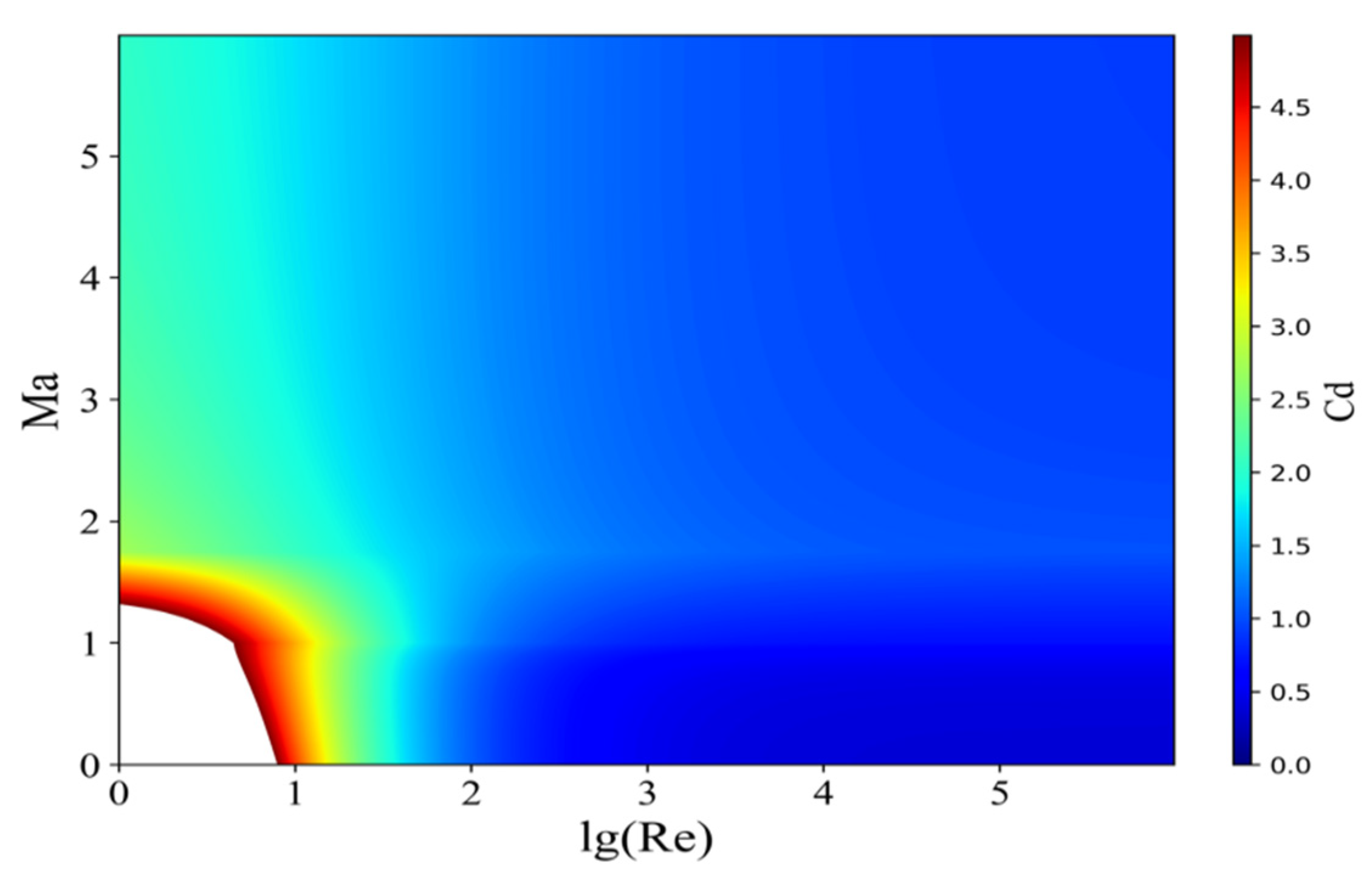


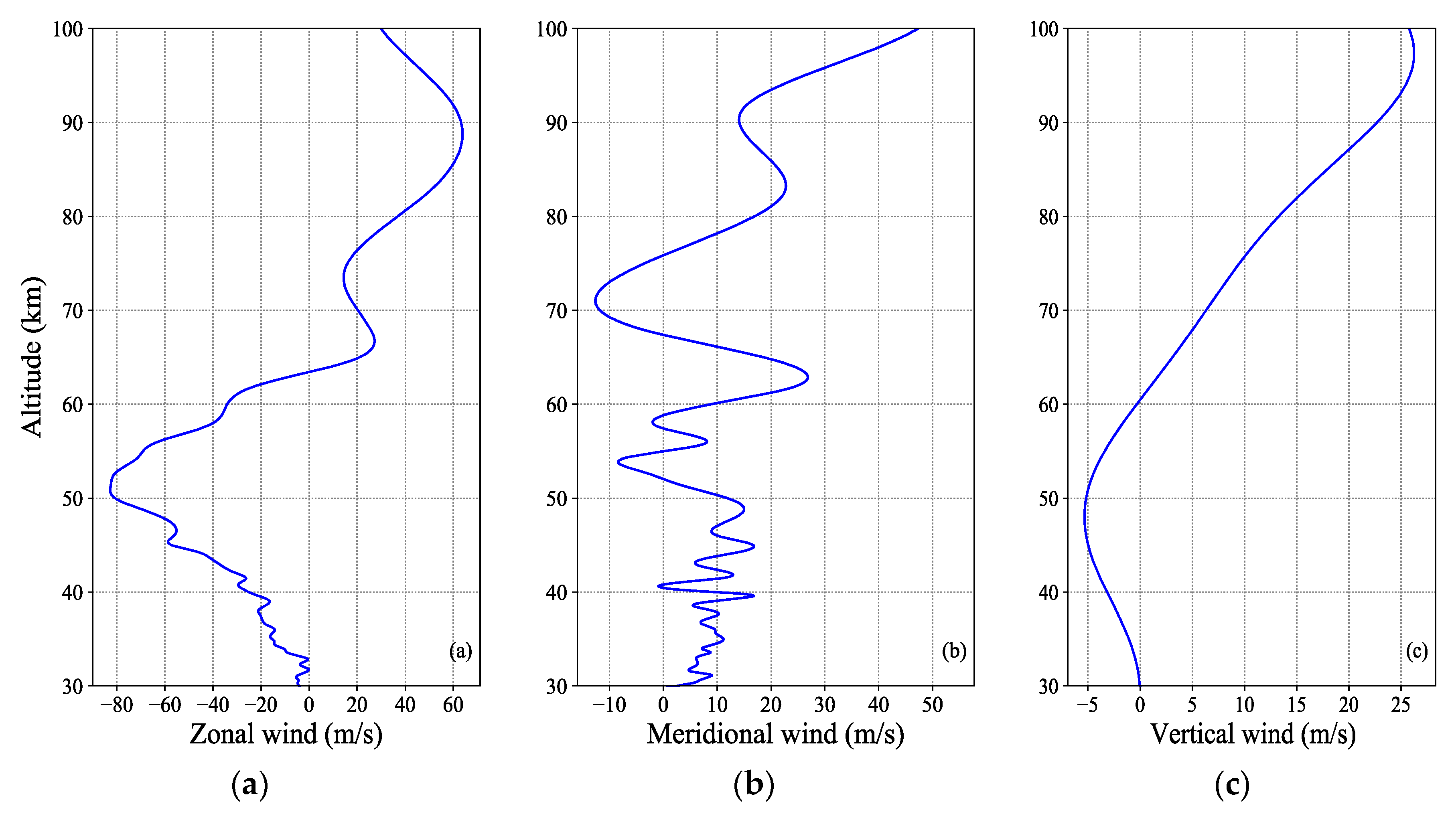
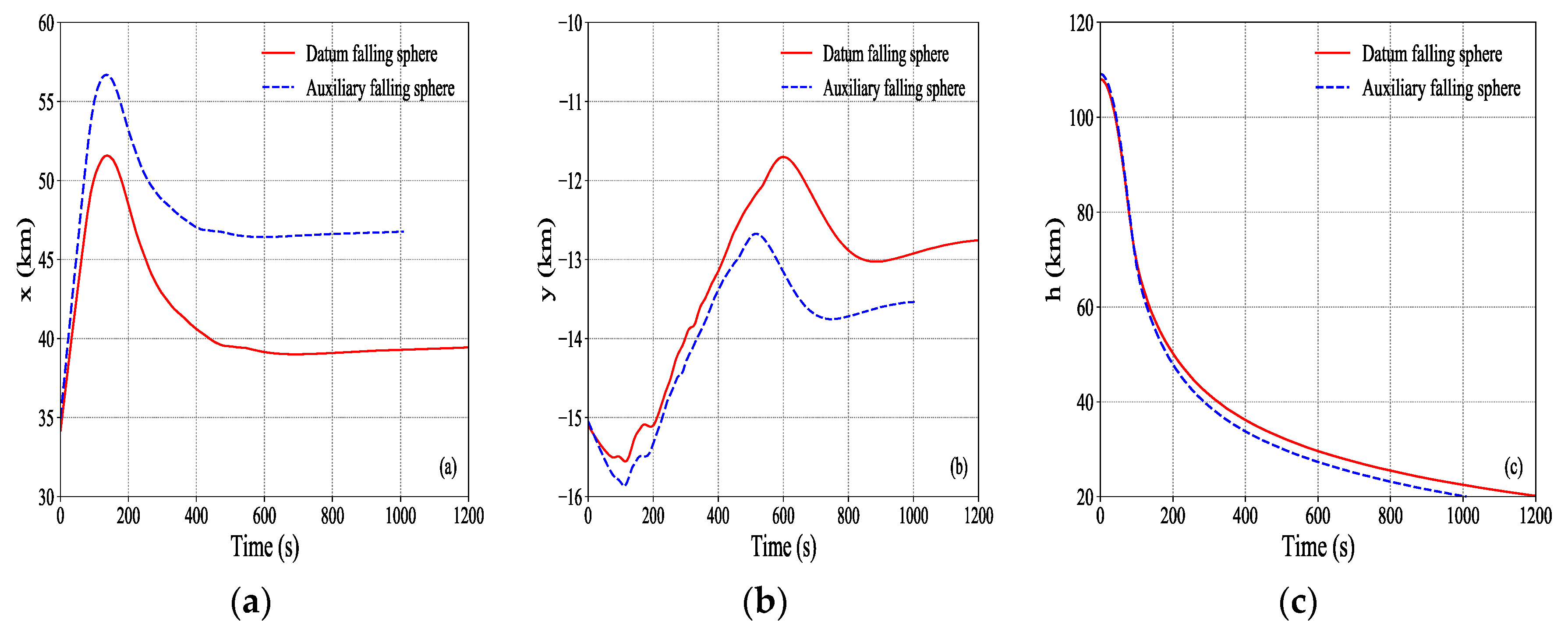
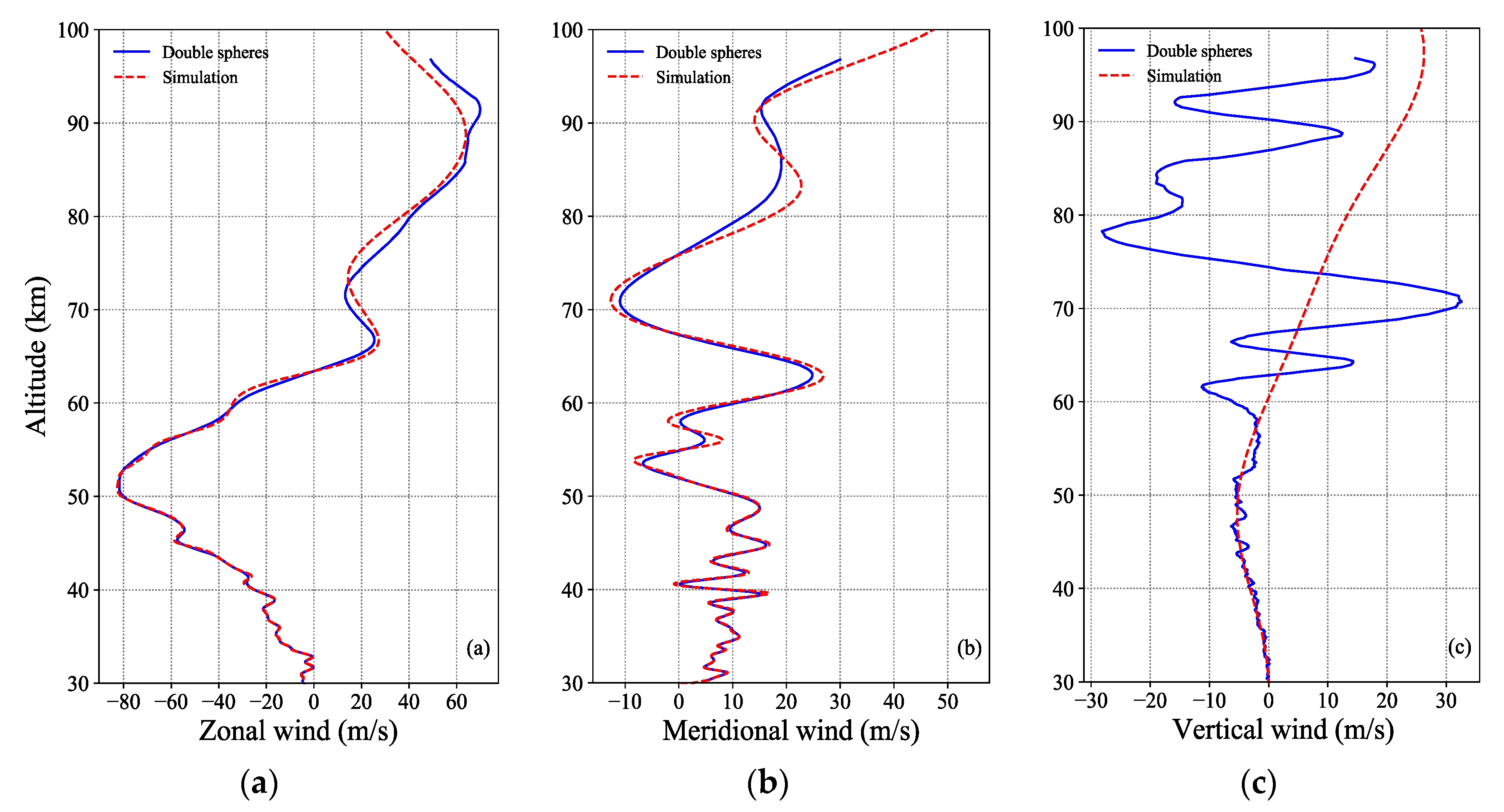
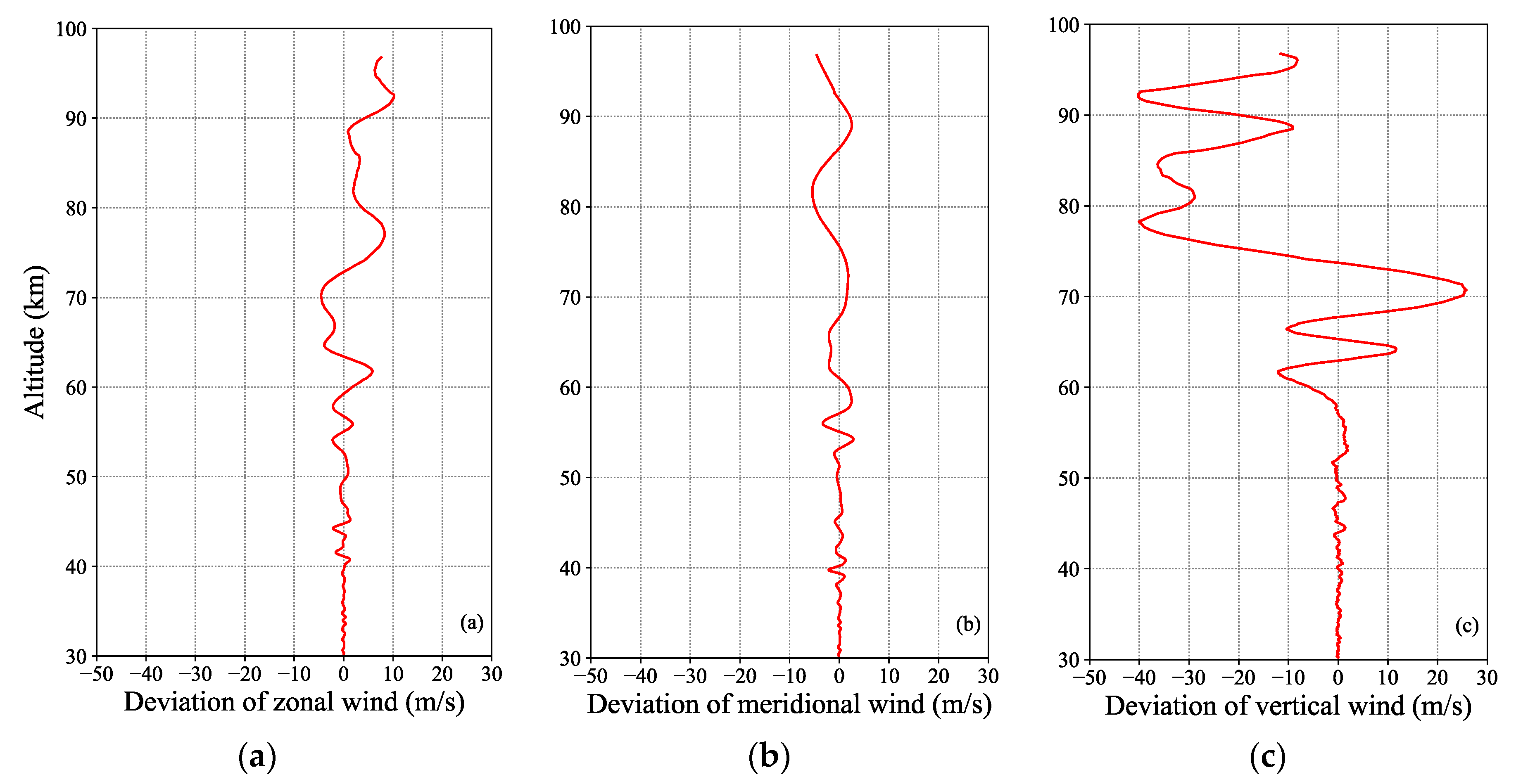
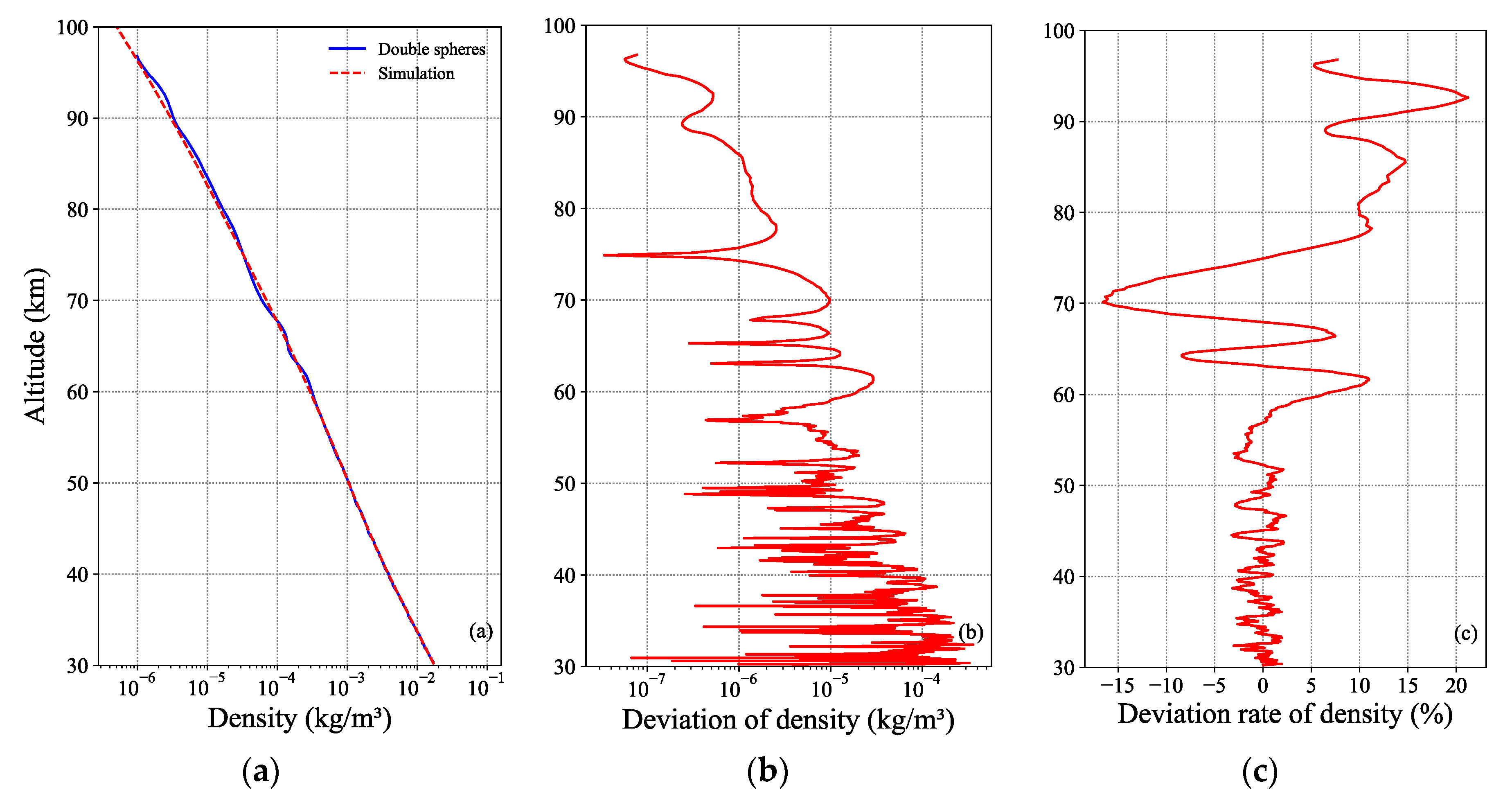

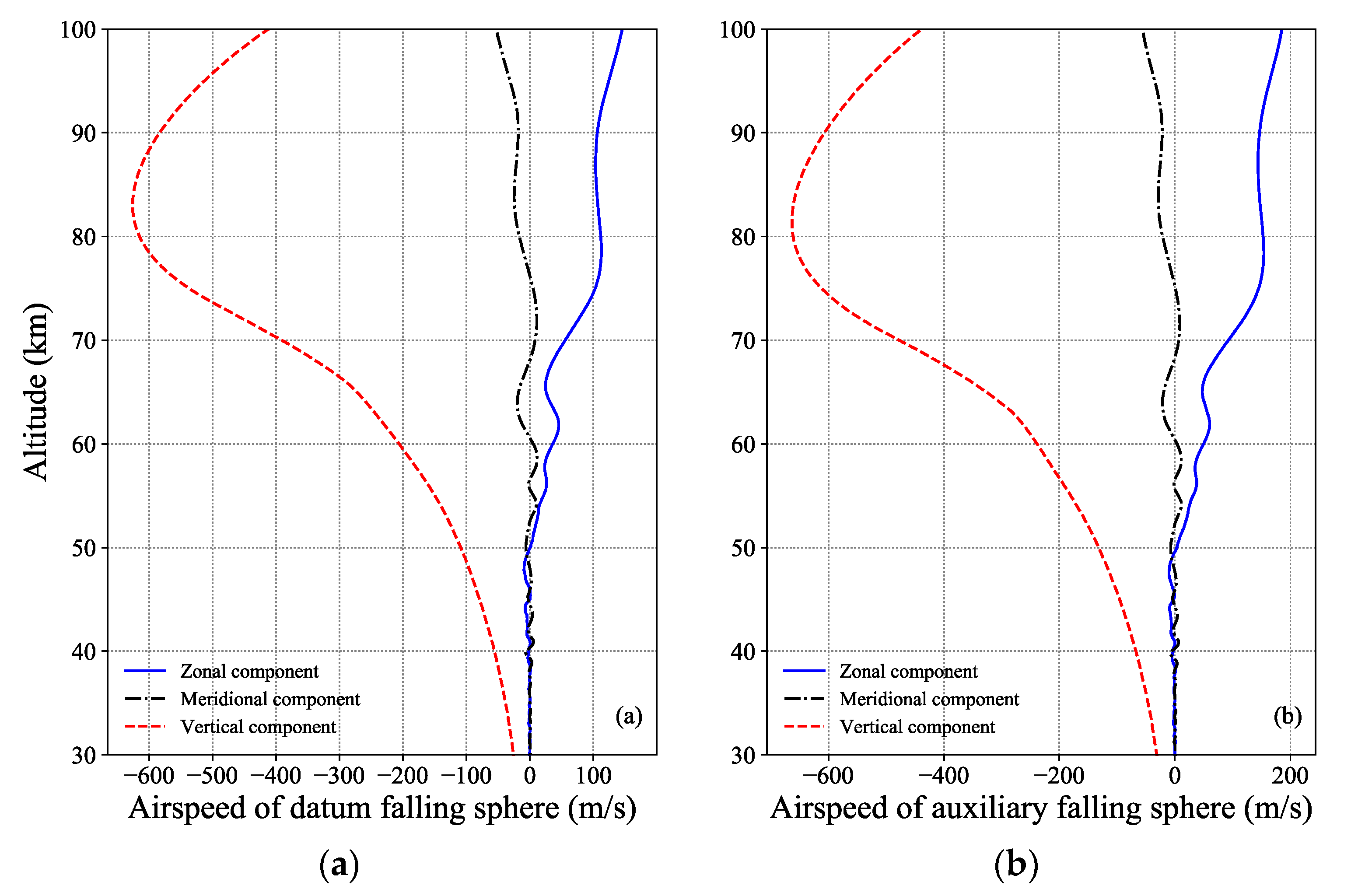
Publisher’s Note: MDPI stays neutral with regard to jurisdictional claims in published maps and institutional affiliations. |
© 2020 by the authors. Licensee MDPI, Basel, Switzerland. This article is an open access article distributed under the terms and conditions of the Creative Commons Attribution (CC BY) license (http://creativecommons.org/licenses/by/4.0/).
Share and Cite
Wu, Y.; Sheng, Z.; Zuo, X.; Yang, M. A Simulation Experiment to Retrieve the Atmospheric Density and Three-Dimensional Wind Field by Double Falling Spheres. Atmosphere 2020, 11, 1312. https://doi.org/10.3390/atmos11121312
Wu Y, Sheng Z, Zuo X, Yang M. A Simulation Experiment to Retrieve the Atmospheric Density and Three-Dimensional Wind Field by Double Falling Spheres. Atmosphere. 2020; 11(12):1312. https://doi.org/10.3390/atmos11121312
Chicago/Turabian StyleWu, Yue, Zheng Sheng, Xinjie Zuo, and Minghao Yang. 2020. "A Simulation Experiment to Retrieve the Atmospheric Density and Three-Dimensional Wind Field by Double Falling Spheres" Atmosphere 11, no. 12: 1312. https://doi.org/10.3390/atmos11121312
APA StyleWu, Y., Sheng, Z., Zuo, X., & Yang, M. (2020). A Simulation Experiment to Retrieve the Atmospheric Density and Three-Dimensional Wind Field by Double Falling Spheres. Atmosphere, 11(12), 1312. https://doi.org/10.3390/atmos11121312




